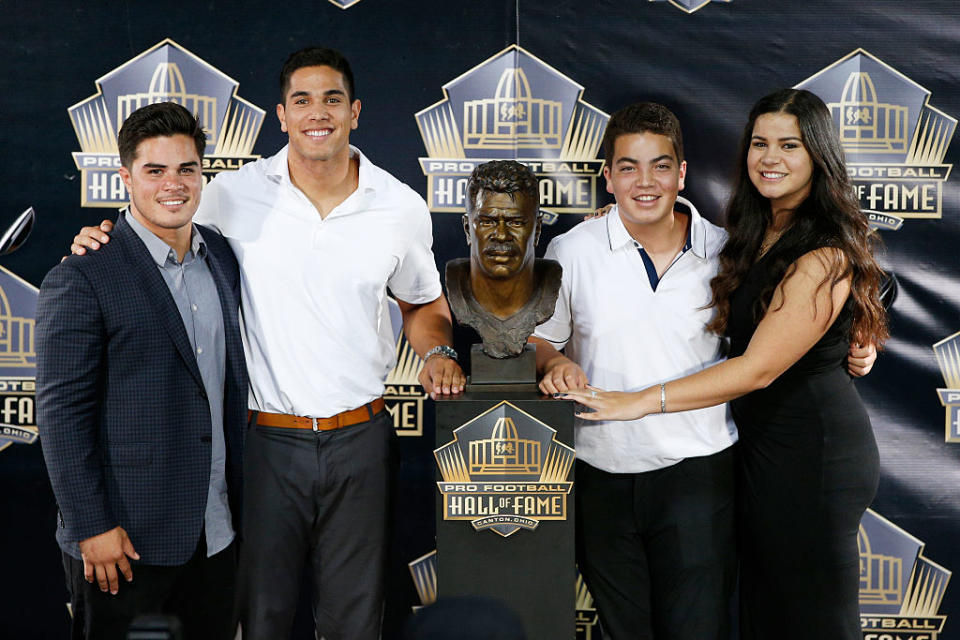'Seau,' new documentary, traces an NFL tragedy

There’s a grim sequence about a third of the way through “Seau,” the powerful new “30 for 30” documentary from ESPN, that, through the lens of 2018 football, seems unthinkable. It’s a montage of hits laid by and on Junior Seau, one of the finest linebackers in NFL history, and the crack of the helmets sounds like the snapping of bones.
Hit after hit, helmets leading, players staggering, each one worthy of an ejection in the modern NFL, each one just part of the game in the 1990s. Each one another clue to unraveling the tragedy of Seau’s life.
The documentary, which airs Thursday on ESPN+, traces Seau’s sad downward arc, from stardom to Super Bowl to suicide. It’s a tale of a life cut short, but it’s also the story of how a league and a nation of football fans realized, with growing horror, the terrible price that repeated concussions exact on football players.
Produced with the full cooperation of Seau’s family, the documentary benefits immensely from behind-the-scenes access, beginning with home movies of Seau goofing with his children in the early 1990s. The Seau that we meet in the earliest minutes of the documentary is everyone’s best friend, everyone’s ideal of the perfect celebrity – in short, everyone’s “buddy,” in his words.

Seau: Amazing from the start
A phenomenal athlete from his youth, Seau established himself as a San Diego-area legend while still in high school. But from the start, tensions that would shape Seau’s life were simmering. His father withheld love and approval but threw out criticism by the bucketful, making sure that Seau knew that losing on the football field meant he was embarrassing the entire family. Cultural expectations of Seau’s Samoan heritage meant that everyone around him expected him to take care of them.
And for a very long time, he could. In a remarkable stroke of draft luck, Seau ended up with his hometown Chargers, and began carving a streak of destruction across the NFL. He tore up offenses, he reworked entire game plans, he made quarterbacks reconsider their career decisions.
It’s fascinating to watch the game sequences from this era; routine hits then would be Twitter referendums on the violence of the game today. Helmets slam into one another — sometimes hard enough to literally crack — and players howl in pain. During one game against the Bears, Seau — playing tight end — took a hard enough hit to open up a gash on his chin. Not only did he not leave the game, he got his chin stitched up on the sideline and returned to action.
“When I’m done, when I hang up my helmet, they might say, ‘You were a fool,’” Seau says in archival footage. “But playing with pain for Junior is a must.”
The long fall for Junior Seau
In the moments of Seau’s triumphs, we see the seeds of his fall. He reaches the Super Bowl with the Chargers, but the 49ers blow out San Diego in humiliating fashion. (And his father blames Seau, saying Seau embarrassed the family.) The Chargers would never return, and in 2002, San Diego dealt Seau to Miami in a cold business decision. After two unremarkable years, the Dolphins released him, and Seau returned to San Diego for a retirement ceremony that should have been a happy ending to his career.
It wasn’t. Days afterward, Seau joined the New England Patriots, chasing a ring. He was on that famous 16-0 team, and reached another Super Bowl … but he was on the field when Eli Manning threw that miracle to David Tyree. The shot of Seau lying face down on the turf while the Giants celebrate around him is heartbreaking.
At the same time, Seau’s personal life was unraveling. He divorced his wife, who’d grown weary of trying to guess his moods – “I never knew which Junior was going to show up,” she says – and grew ever more distant from his children. Aimless, he bounced from ex-jock job to ex-jock job – running a restaurant, doing reality TV – but never with the verve he’d shown on the field. He ran up astronomical bills in Vegas.
Saddest of all, he built walls to keep out his children. There’s a sequence here where his children try to reach him, through tears, pleas and letters … and he dismisses them all. So it’s sad but unsurprising that when Seau, just hours before his suicide, sends a last group text message to his children – “I love you” – none of them respond.
As Seau’s life spiraled downward, awareness of concussions and knowledge of their potentially devastating effects was growing. In the last months of Seau’s life, a wave of player suicides put the spotlight on how concussions can lead to the degenerative brain disease CTE. Seau killed himself with a gunshot to the chest, and the later examination found CTE in his brain.
The documentary is a powerful look at a player described as a “force of nature,” and the very fact that CTE, in part, claimed him has helped put a spotlight on the dangers of concussions. CTE changed Seau’s mood, personality and outlook, and the tragedy is that the same qualities that made him a force on the football field kept him from admitting his deep need off of it.
“We suffer in silence, we keep our game faces on,” Seau’s teammate Aaron Taylor says. “The irony is, those things get the better of us.”
“Seau” airs Thursday on ESPN+.

____
Jay Busbee is a writer for Yahoo Sports. Contact him at jay.busbee@yahoo.com or find him on Twitter or on Facebook.
More from Yahoo Sports:
• Meyer’s grim warning to NFL team about Aaron Hernandez
• School official sorry for racist remark about Texans QB
• New book claims Brady feels ‘trapped’ with Belichick
• Red Sox fans make problematic discovery

